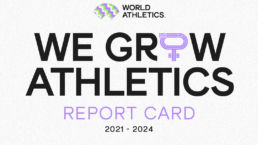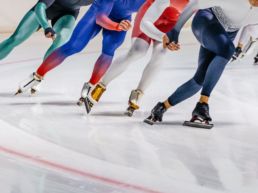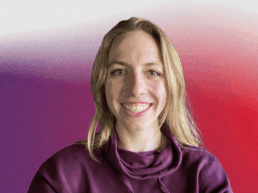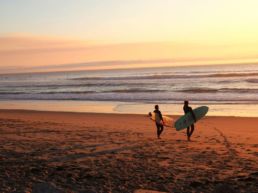Michelle Sammet, World Athletics' Head of Stakeholder Relations, breaks down the success of their #WeGrowAthletics campaign, and why improving gender equality is so important in Athletics.
Three years on from its launch, World Athletics is celebrating the success of its #WeGrowAthletics campaign built around International Women’s Day and designed to do more to improve gender equity and close the gender gap in athletics. Can you explain why you think tackling gender imbalance is so important?
Yes, the campaign was designed to recognise that gender equality plays a huge role in growing our sport globally. If you look at athletics on the field of play, we are doing really well. At the World Indoor Championships in Glasgow, for example, there were more female than male competitors for the first time in our sport’s history, although our events have always been quite balanced in terms of opportunity: athletes compete in the same number of disciplines, compete at the same time, and receive the same prize money.
But this hasn’t been the case across the board, especially in terms of leadership. So, with #WeGrowAthletics we wanted to commit publicly to some very concrete and specific pledges to make changes to the gender balance at the very top of our sport. By committing to these pledges, it meant that we could hold ourselves accountable and can track and measure progress over the last three years.
One of the things our President, Sebastian Coe, has said consistently is that if we are a balanced organisation at the leadership level, we will be a well-governed sport, and as a well-governed sport, will be able to protect the future of athletics. Three years into the campaign, the case is being proven.
What are your desired outcomes from this continued project?
We wanted to scrutinise our ecosystem as an organisation: what we do in functional areas and where there is room for improvement. So, the first year we launched the project – and continuously throughout – we’ve looked at communications, competition, development and events to evaluate where there are gaps that need filling. Some changes could be implemented quickly, especially when we realised that in some areas we were doing certain things just because they had always been done that way. Like the fact that our stats pages were defaulting to men so those pages had much higher views, leading to the assumption that these events were more popular.
Another example is investigating our freelance network. We realised it was largely male-dominated – especially in the realm of commentators and photographers. We’ve therefore been identifying ways to develop female talent through our media development programmes, and have partnered with organisations like Black Women Photographers on certain projects.
One of the big challenges we’re aware of is that educational workshops may not be as accessible for women who are caregivers or have other responsibilities. We’ve made sure our courses are now available as eLearning courses that can be taken by anyone, anywhere in the world and in their own time. It’s helping open up those opportunities for women that weren’t necessarily there in the past.
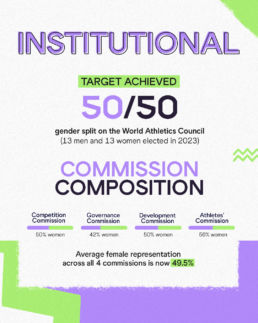
What additional resources or strategies have you had to put in place to support these outcomes?
The big thing for us was to put our pledges out there and commit to taking action. We challenged our stakeholders to do the same and have had pledges from partners such as Mondo, World Athletics Series Event Local Organising Committees and others. It’s about highlighting the fact that we need our partners to buy into the same mission and do things in their respective areas of expertise to grow talent and help support women.
We’ve got a particularly strong Gender Leadership Taskforce that drives us forward and holds us accountable. They help us challenge ourselves to address what we’re lacking. So far, it’s been extremely encouraging to see how that’s been received by everyone involved – from the Member Federation level all the way to local clubs.
What has your research identified?
It’s been more than a research project for us because it’s a way to collect the data we need to support positive change. It’s then about implementing those changes.
What we have seen is that we’ve made some great strides over the years. For example, a big focus – even prior to this campaign – were reforms introduced by President Sebastian Coe in 2016, where some clear structures were put in place to help us move towards gender equality at the leadership level. We had a schedule mapped out to increase the representation of women on our Council between the elections in 2019, 2023 and 2027. The idea was to be a gender-equal Council by 2027 but we actually managed to reach that goal in 2023 which is really encouraging to see. We now have a fully gender-equal Council and an average female representation of 49.5% across our four Commissions – Development, Governance, Competition and the Athletes’ Commission.
We’ve also analysed, highlighted and reported instances of gender-based abuse online. Specifically, we’ve seen over time that female athletes are targeted a lot more online than their male counterparts. It’s important to make the platforms aware of this and make sure the athletes are protected.
What advice would you give to other IFs wanting to support gender equality/women’s sport?
I think the biggest advice to give to other International Federations is to take an honest look at themselves, the data they have and what data they’re missing, and implement changes based on the research.
As I said, we’ve put quotas in place for our Council and we’ve set ourselves realistic targets with regards to what we knew needed to happen at the Member Federation and Area level so women could progress in leadership positions. It’s good to set goals and measurable KPIs that you can look back on to see whether you’re on track or maybe need to put more emphasis in some of the spaces.
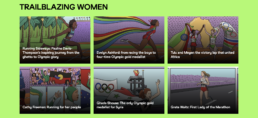
What decisions have you made within your digital strategy to ensure you actively support gender equality?
One thing we are putting an emphasis on is who is creating the content, because the voices that tell stories are equally as important as the people they talk about. They can provide a different perspective. And that’s not just regarding gender but about where they’re coming from in the world.
When it comes to telling athletes stories, it’s about focusing on the inspirational stories within our sport. There are so many incredible stories of athletes who have returned after maternity, but there are great stories, too, of for example, female coaches or technical officials.
For the last three years, we’ve celebrated World Athletics Women’s Week, during which our content is about inspiring women, created and published by women. It’s like a mini celebration of everything we try to do throughout the year, just amplified during this time.


